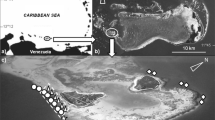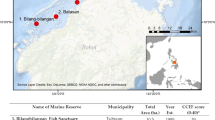Abstract
This paper used the case study of the Wakatobi Marine National Park, Indonesia to examine changes in the diversity, density and maturity of grouper species over a 5-year period following the establishment of a small-scale no-take area (NTA). This work was carried out to investigate whether “small” NTAs could be effective management strategies over a time scale that is relevant to local fishery communities and their perception of management success. Our research also documents the ecology of these species, information essential if we are to understand how management practises are to affect coral reef fish species. Designation of this “small NTA” increased the density of groupers by 30% over a 5-year period of protected status. After 5 years of protection, grouper populations within this NTA were more mature and double the density of those within the adjacent lightly fished sites and nearly five times those of a heavily fished site. During this time all other nearby fished sites underwent large declines in grouper density. The nearby lightly fished Kaledupa site decreased by up to 50% year−1. Such drastic declines are considered the impact of the exponential development of ever efficient and unsustainable methods of fishing within the study region. This NTA was not of benefit to all grouper species; the reasons for which are not clear. Such questions require further detailed research about the life history, population and behavioural ecology of Indo-Pacific grouper species. Such information is critical for urgently needed fisheries management. The present study found that a small scale NTA of 500 m length was large enough to increase the population of top predatory fish. In conjunction with other socially acceptable small scale NTAs it could help maintain and increase important fish stocks over a larger area. The use of “small” NTAs within networks of reserves should become a useful tool in the management of the locally exploited coral reefs.







Similar content being viewed by others
References
Ballantine WJ (1997) ‘No-take’ marine reserve networks support fisheries. In: Hancock DA Smith DC, Grant A, Beumer JP (eds) Developing and sustaining world fisheries resources: the state of science and management. CSIRO, Collingwood, pp 702–706
Beet J, Friedlander A (1992) Stock analysis and management strategies for red hind, Epinephelus guttatus, in the U.S. Virgin Islands. Proc Gulf Carib Fish Inst 42:66–79
Bell JD, Craig GJS, Pollard DA, Russell BC (1985) Estimating length frequency distributions of large reef fish underwater. Coral Reefs 4:41–44
Bohnsack JA (1994) The impacts of fishing on coral reefs. In: Ginsburg RF (ed) Proceedings of the colloquium on global aspects of coral reefs: health hazards and history. RSMAS, University of Miami, Coral Gables, pp 169–199
Chabanet P, Ralambondrainy H, Amanieu M, Faure G, Galzin R (1997) Relationships between coral reef substrata and fish. Coral Reefs 16:93–102
Chiappone M, Sluka R, Sealey KS (2000) Groupers (Pisces: Serranidae) in fished and protected areas of the Florida Keys and northern Caribbean. Mar Ecol Prog Ser 198:261–272
Clarke KR (1993) Non-parametric multivariate analysis of changes in community structure. Aust J Ecol 18:117–143
Clarke KR, Ainsworth M (1993) A method of linking multivariate community structure to environmental variables. Mar Ecol Prog Ser 92:205–219
Colin PL (1992) Reproduction of the Nassau grouper, Epinephelus striatus (Pisces: Serranidae) and its relationship to environmental-conditions. Environ Biol Fish 34:357–377
Costa PAS, Braga AD, da Rocha LOF (2003) Reef fisheries in Porto Seguro, eastern Brazilian coast. Fish Res 60:577–583
Crabbe MJC, Smith DJ (2002a) Comparison of two reef sites in the Wakatobi Marine National Park (SE Sulawesi, Indonesia) using digital image analysis. Coral Reefs 21:242–244
Crabbe MJC, Smith DJ (2002b) Computer modelling and estimation of recruitment patterns of non-branching coral colonies at three sites in the Wakatobi Marine Park, S. E. Sulawesi, Indonesia; implications for coral reef conservation. Comp Biol Chem 27:7–27
Crabbe MJC, Smith DJ (2005) Sediment impacts on growth rates of Acropora and Porites corals from fringing reefs of Sulawesi, Indonesia. Coral Reefs 24:437–441
Crosby MP, Reese ES (1997) A manual for monitoring coral reefs with indicator species: butterfly fishes as indicators of change on Indo-Pacific reefs. Office of Ocean and Coastal Resource Management, National Oceanic and Atmospheric Administration, Silver Spring
Cullen LC, Smith DJ, Pretty J (2006) Economic importance of marine resources in the Wakatobi Marine National Park: ecological-economic status. In: Proceedings of the ninth biennial conference of the international society of ecological economics: ecological sustainability and human well-being. New Delhi, 15–19 December 2006
Donaldson TJ (2002) Habitat association and depth distribution of two sympatric groupers of the genus Cephalopholis (Serranidae: Epinephelinae). Ichthyol Res 49:191–193
Donaldson TJ (1995a) Partitioning behaviour and intra- and interspecific interactions: a comparison between male and female groupers, Cephalopholis spiloparaea (Pisces: Serranidae: Epinephelinae). Mar Biol 121:581–584
Donaldson TJ (1995b) Courtship and spawning behaviour of the pygmy grouper Cephalopholis spiloparea (serranidae: ephinephelinae) with notes on C. argus and C.urodeta. Env Biol Fish 43:363–370
Dorenbosch M, Grol MGG, Christianen MJA, Nagelkerken I, van der Velde G (2005) Indo-Pacific seagrass beds and mangroves contribute to fish density and diversity on adjacent coral reefs. Mar Ecol Prog Ser 302:63-76
Elliot G, Mitchell B, Wiltshire B, Manan IRA, Wismer S (2001) Community participation in marine protected area management: Wakatobi National Park, Sulawesi, Indonesia. Coast Manage 29:295–316
English S, Wilkinson C, Baker V (eds) (1997) Survey manual for tropical marine resources, 2nd edn. Australian Institute of Marine Sciences, Townsville, pp 363–376
Ferreira BP, Russ GR (1995) Population structure of the coral trout Plectropomus leopardus on fished and un-fished reefs off Townsville, central Great Barrier Reef, Australia. Fish Bull 93:629–642
Ferraris J, Pelletier D, Kulbickil M, Chauvet C (2005) Assessing the impact of removing reserve status on the Abore Reef fish assemblage in New Caledonia. Mar Ecol Prog Ser 292:271–286
Froese R, Pauly DE (2005) FishBase. World wide web electronic publication version (April 2006)
Forrester GE (1999) The influence of adult density on larval settlement in a coral reef fish, Coryphopterus glaucofraenum. Coral Reefs 18:85–89
Fowler AJ (1987) The development of sampling strategies for population studies of coral reef fishes. Coral Reefs 6:49–58
Gell FR, Roberts CM (2002) The fishery effects of marine reserves and fishery closures. WWF-US 1250 24th Street, NW, Washington, DC, 20037
Grigg RW, Dollar SJ (1990) Natural and anthropogenic disturbances on coral reefs. In: Dubinsky Z (ed) Ecosystems of the world. Coral Reefs 25:439–452
Gomez ED, Alino PM, Yap HT (1994) A review of the status of Philippine reefs. Mar Poll Bull 29:62–68
Hastings A, Botsford LW (2003) Comparing designs of marine reserves for fisheries and for biodiversity. Ecol Apps 13 (Suppl): s65–s70
Hopley D, Suharsono H (2000) The status of coral reefs in eastern Indonesia. Australian Institute of Marine Science, Townsville
Lee C, Y Sadovy (1998) A taste for live fish: Hong Kong’s live reef fish market. Naga ICLARM Q 21(2):38–42
Lorance P, Souissi S, Uiblein F (2002) Point, alpha and beta diversity of carnivorous fish along a depth gradient. Aquat Living Resour 15:263–271
Marsh LM, Bradbury RH, Reichelt RE (1984) Determination of the physical parameters of coral distribution using line transect data. Coral Reefs 2:175–180
May D (2003) A preliminary assessment of the small-scale tropical fisheries of Kaledupa Island, Wakatobi Marine National Park, SE Sulawesi, Indonesia. Operation Wallacea technical report. http://www.opwall.com
May D (2005) Folk taxonomy of reef fish and the value of participatory monitoring in Wakatobi National Park, southeast Sulawesi, Indonesia. SPC Trad Mar Res Manage Knowl Info Bull 18:18-35
Maypa AP, Russ GR, Alcala AC (2002) Long-term trends in yield and catch rates of the coral reef fishery at Apo Island, central Philippines. Mar Fresh Res 53:207–213
McClanahan TR, Mangi SC (2000) Spill-over of fishes from a marine park and its effects on the adjacent fishery. Ecol Appl 10:1792–1805
McClanahan TR, Mangi SC (2004) Gear-based management of a tropical artisanal fishery based on species selectivity and capture size. Fish Man Ecol 5:11
McCormick M (1994) Comparison of field methods for measuring surface topography and their associations with a tropical reef fish assemblage. Mar Ecol Prog Ser 112:87–96
McCormick MI, Choat JH (1987) Estimating total abundance of a large temperate-reef fish using visual strip-transects. Mar Biol 96:469–478
Mumby PJ, Edwards AJ, Arias-Gonza´lez JE, Lindeman KC, Blackwell PG, Gall A, Gorczynska MI, Harborne AR, Pescod CL, Renken H, Wabnitz CCC, Llewellyn G (2004) Mangroves enhance the biomass of coral reef communities in the Caribbean. Nature 427:533-536
Nakai T, Sano M, Kurokura H (2001) Feeding habits of the Darkfin hind Cephalopholis urodeta Serranidae at Iriomote island southern Japan. Fish Sci 67:640–643
Palumbi SR (2003) Population genetics, demographic connectivity, and the design of marine reserves. Ecol Appl 13 (Suppl): s146–s158
Pet-Soede L, Rijoly F, Erdmann MV, Halford A, Fudge J (2003) Commercial fish abundance and fisheries characteristics in Wakatobi Marine National Park—some observations. In: Pet-Soede L, Erdmann MV (2003) Rapid ecological assessment Wakatobi Marine National Park. TNC, WWF joint publication
Pretty J, Smith DJ (2004) The role of social capital in biodiversity management. Conserv Biol 18:631–638
Roberts CM, Halpern B, Palumbi SR, Warner RR (2001) Designing networks of marine reserves: why small, isolated protected areas are not enough. Conserv Biol Prac 2:10–17
Russ GR, Alcala AC (1996) Marine reserves: rates and patterns of recovery and decline of large predatory fish. Ecol Appl 6:947–961
Sadovy Y, Colin PL (1995) Sexual development and sexuality in the Nassau grouper. J Fish Biol 46:961–976
Samoilys MA (1987) Aspects of the behaviour, movements and population density of the coral trout, Plectropomus leopardus (Lacepede) (Pisces: Serranidae), at Heron Island, southern Great Barrier Reef. Unpublished MSc Thesis, University of Queesland, p 185
Samoilys MA (1997a) Movement in a large predatory fish: coral trout. Plectropomus leopardus (Pisces: Serranidae), on Heron Reef, Australia. Coral Reefs 16:151–158
Samoilys MA (1997b) Movement in a large predatory fish: coral trout, Plectropomus leopardus (Lacepede) (Pisces: Serranidae), at Heron Island, southern Great Barrier Reef. Coral Reefs 16:151–158
Samoilys MA (1997c) Periodicity of spawning aggregations of coral trout Plectropomus Leopardus (Pisces: Serranidae) on the northern Great Barrier Reef. Mar Ecol Prog Ser 160:149–159
Shpigel M, Fishelson L (1989) Food habits and prey selection of three species of groupers from the genus Cephalopholis (Serranidae: Teleostei). Environ Biol Fish 24:67–73
Sluka RD, Chiappone M, Sealey KM (2001) Influence of habitat on grouper abundance in Florida Keys, USA. J Fish Biol 58:682–700
Ward TJ, Heinemann D, Evans N (2001) The role of marine reserves as fisheries management tools: a review of concepts, evidence and international experience. Bureau of Rural Sciences, Canberra, p 192
Webster MS, Almany GR 2002 Positive indirect effects in a coral reef fish community. Ecol Lett 5:549
Zar JH (1984) Biostatistical analysis, 2nd edn. Prentice-Hall, Englewood Cliffs
Acknowledgments
The authors thank the staff at the Hoga Marine Research Centre for their logistic support and Operation Wallacea who provided financial support for travel and fieldwork. Richard Unsworth is grateful to Dr. Tim Coles and Operation Wallacea for providing a doctoral studentship. This research would not have been possible without the assistance of numerous volunteers throughout the reef-monitoring programme. The authors declare that all research carried out for this publication complies with the current laws of Indonesia and the United Kingdom.
Author information
Authors and Affiliations
Corresponding author
Additional information
Communicated by M. Kühl.
Rights and permissions
About this article
Cite this article
Unsworth, R.K.F., Powell, A., Hukom, F. et al. The ecology of Indo-Pacific grouper (Serranidae) species and the effects of a small scale no take area on grouper assemblage, abundance and size frequency distribution. Mar Biol 152, 243–254 (2007). https://doi.org/10.1007/s00227-007-0675-3
Received:
Accepted:
Published:
Issue Date:
DOI: https://doi.org/10.1007/s00227-007-0675-3




